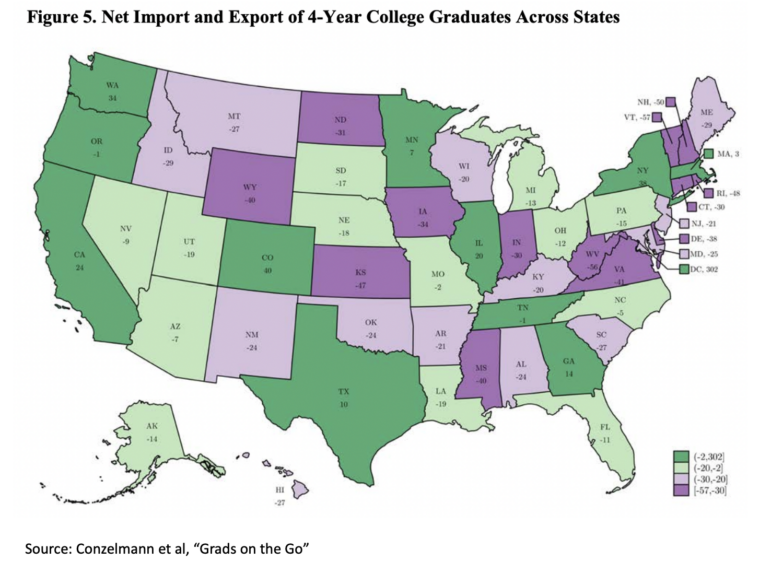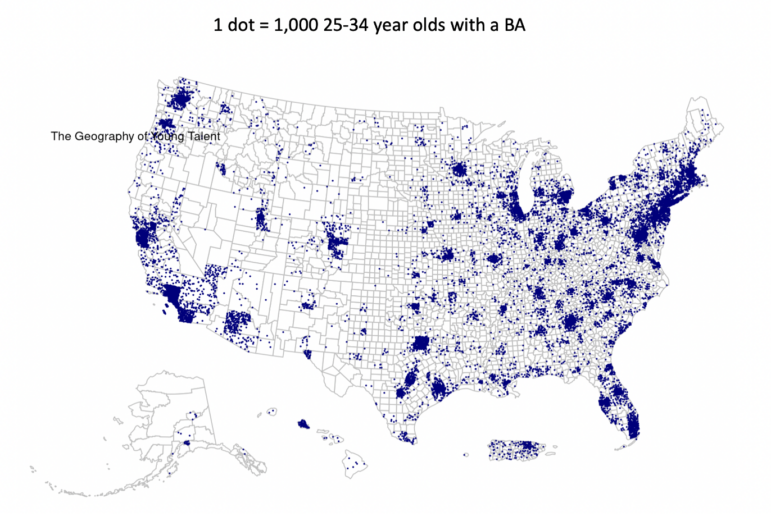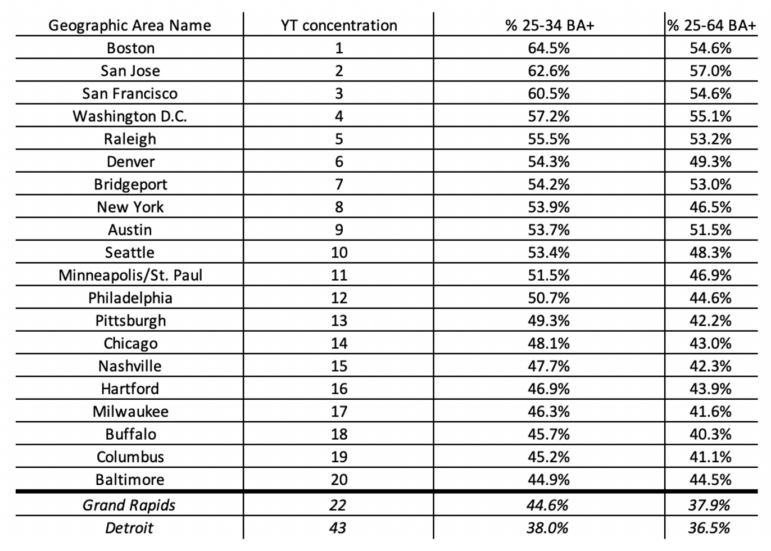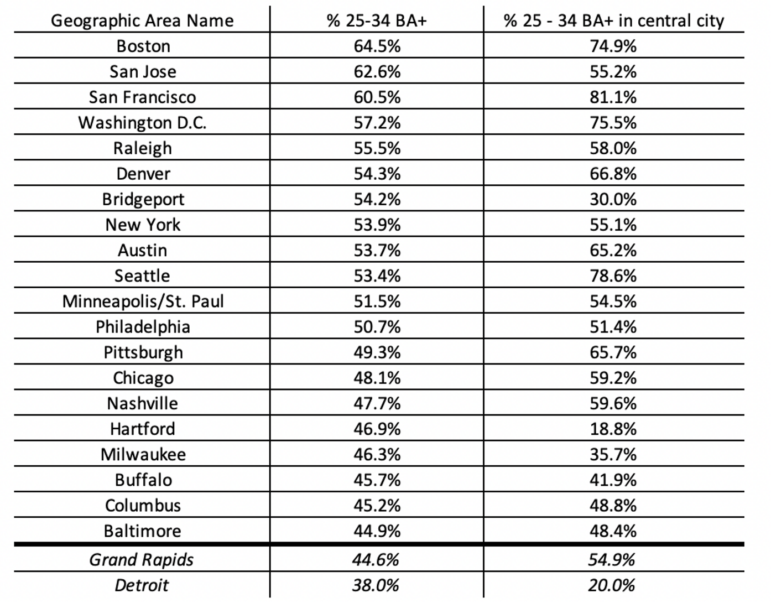In my last post, I looked at the connection between the educational attainment of the working-age population of a region or state, and the prosperity of that region or state. The short story is that at both geographic levels, the two variables are strongly correlated – if you tell me what share of 25-64 year olds in a region or state have a bachelor’s degree or more, I can give you a pretty good estimate of that region or state’s per-capita income.
And of these two geographies, the one that really matters is the region, or metropolitan area, as the vast majority of highly educated folks congregate in large metropolitan areas.
At present, metro Detroit and metro Grand Rapids have relatively low educational attainment, and, therefore, relatively low per-capita income. Thirty-eight percent of the working age population in metro Grand Rapids has a bachelor’s degree or higher, and 37% of those in metro Detroit do, placing them 35th and 41st, respectively, in educational attainment among the nation’s 58 largest metros. Both are in the bottom twenty big metros in per-capita income.
Given all this, the core economic development question should be: how do we increase the educational attainment of our major metropolitan areas? First, we need more Michiganders to earn a bachelor’s degree. And second, we need to keep those college graduates in Michigan, as well as attract young college graduates from anywhere in the world. This post will explore that second strategy – creating places in Michigan that are attractive to young college graduates, both those from Michigan, and anywhere else.
Attracting and retaining young talent
In a paper released last year, a group of economists used data from LinkedIn to quantify the extent of so-called “brain drain” by state. To do this they compared the number of college graduates living in a state to the number of folks who graduated from a college in that state. The key figure from their analysis is below. The number shown in each state is the net increase or decrease (in percent terms) of college graduates living in the state compared to the number of folks who graduated from college in that state. The dark green states are net importers of talent, or are at least roughly even. These are states with more college graduates living in that state than who graduated from a college in that state. The rest of the states are net exporters of talent, with the light green states doing just okay, the light purple states doing worse, and the dark purple states doing really poorly in terms of holding on to or attracting new college graduates.

Michigan is a light green state, with 13% fewer college graduates living in Michigan than graduated from Michigan colleges. This is equivalent to roughly 260,000 fewer college graduates between the ages of 25-64 living in Michigan than would be had we held on to all the folks graduating from Michigan colleges.
Of course, the goal is not to hold on to every person that graduates from a Michigan college. Young college graduates are a very mobile bunch, and they can and should move to opportunities across the country and across the globe. The goal, rather, is to make Michigan a place where enough graduates from Michigan colleges want to remain, and enough graduates from colleges across the country and all over the world want to flock to, such that these net migration figures even out, and, ideally, tip Michigan into the dark green.
So, what is distinctive about the net-importing states? What makes these states attractive spots to land for college-educated individuals, and, in particular, those very mobile young college-educated individuals? What can Michigan learn from these states?
Years of data have told us that young, college-educated individuals are moving to the central cities of large metropolitan areas, and in particular those cities that feature dense, walkable, activity-rich neighborhoods. And what all these net-importing states have in common is that they all have large central cities filled with vibrant, dense neighborhoods, that serve as magnets for today’s young talent. The map above is not so much a map of talent-importing states, but a map of talent-importing cities – Seattle, Portland, San Francisco, Los Angeles, Denver, Austin, Minneapolis, Chicago, Nashville, Atlanta, New York, Boston.
To put a finer point on it, below is a map showing where 25-34 year old college graduates live. Each dot represents 1,000 young college graduates. This map clearly shows that young college graduates are moving almost exclusively to large metros, and clustering most especially in America’s dense, walkable, talent magnets. We talk about states attracting talent, but what we’re really talking about is metros, and more importantly cities, attracting talent.

How are Michigan’s major metropolitan areas doing at attracting young talent? Just 38% of 25-34 year olds in metro Detroit have a bachelor’s degree or more, placing metro Detroit 43rd out of 58 large metros on this young talent concentration metric. Metro Grand Rapids, though still not in the top twenty, scores much better, with 45% of 25-34 year olds with a bachelor’s degree or more. This rate is far higher than that of the entire working age population in Grand Rapids, a sign that the city is attracting young talent, though maybe not yet on the scale that’s needed to drive transformational growth.

Drilling down even further, we find that talent concentration at the metro level is dependent, in large part, on talent concentrations in that metro’s central city. In most metros with high concentrations of young talent, the talent concentration in the central city is even higher than that of the metro as a whole. Indeed, part of the explanation for metro Detroit’s relatively low young talent concentration is that just 20% of 25-34 year olds in the city of Detroit have a bachelor’s degree or more.

So, we know that the educational attainment of a region or state is critical to that region or state’s economic success; we know that to boost educational attainment we need to attract and retain very mobile young college graduates; and we know that young college graduates are seeking out dense, walkable, amenity-rich neighborhoods in the central cities of large metropolitan areas. It follows that our economic development policies in Michigan should be squarely centered on creating more of these kinds of neighborhoods, to attract the young talent that drives the 21st century knowledge economy.
This is why we have proposed the state create a Neighborhood Talent Concentration Initiative (NCTI), focused on developing more dense, walkable, activity-rich neighborhoods in Michigan’s central cities. The initiative would give large grants to support public space development projects in central city neighborhoods or geographically concentrated districts. Crucially, funding would go to support not the development of new buildings, but the public space around the buildings: narrowing streets to promote walkability, developing greenspace for recreation, activating commercial corridors, and flooding the streets with arts and cultural offerings. This is an initiative focused on activating street life and making beautiful public spaces that can be enjoyed by all.
This is the kind of work that has been happening rapidly in cities across the country over the past two decades, but has happened much more slowly and sparingly in our car-dependent metros. Smart Growth America (SGA) puts out an annual report called Foot Traffic Ahead, which ranks America’s large metros by the density of walkable neighborhoods within the metro. Detroit currently ranks 26th out of the 35 largest metros.
This is important because SGA finds that though walkable neighborhoods make up just 1.2% of the landmass in the 35 metros they analyze, those neighborhoods account for nearly 20% of the nation’s GDP, due to the concentration of knowledge industries and knowledge workers in those neighborhoods. The implication being, the more of these neighborhoods we have in Michigan, the larger slice of our nation’s productivity we account for, and the stronger our regional and state economies will be. The goal of the NCTI would be push Michigan cities to create more walkable neighborhoods, at scale, as quickly as possible.
When you put all these pieces together, we can see that what should be our core economic development goals are largely missing from the public discussion. The prosperity of our state depends on the extent to which we can attract and retain talent in our major metropolitan areas and central cities. And our ability to attract and retain talent is dependent on creating the kinds of places where young talent wants to live: dense, walkable, activity and amenity-rich neighborhoods, with a heavy dose of arts, culture, and greenspace. NCTI is a chance to create more of these places, at scale, in Michigan’s central cities.







